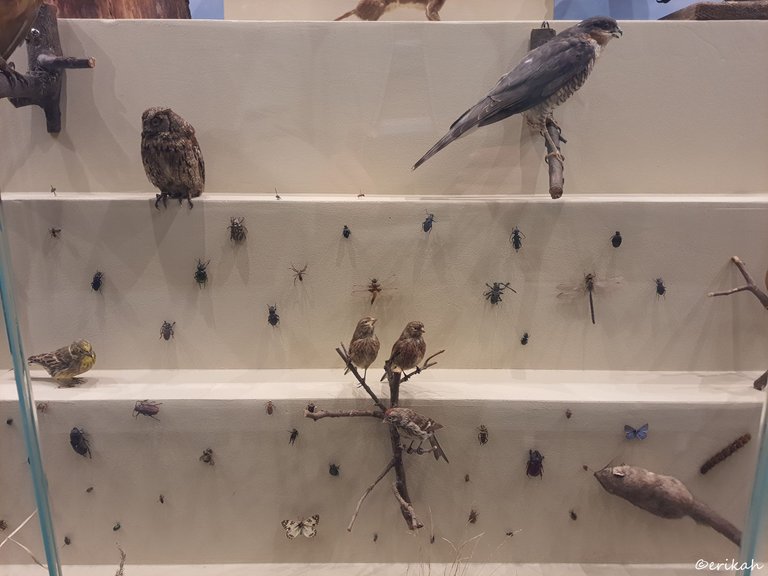A few days ago I showed you the wildlife I saw at the natural science museum museum in February and today I'd like to show you another ecosystem the museum had available, and that was life in the Mures river. I'm not sure if "in" is correct as it wasn't just about the underwater world, but it doesn't really matter. Let's see what this beautiful aquarium looked like.

I was impressed by these huge aquariums, set up with almost everything you would find at the river and in the river. Congrats to the designer, they did an excellent job. My job was a bit harder as I had to fight reflection and light as well, but this is not new.

As the primary purpose of any museum is education, there were these banners, explaining what it was displayed. This helped me a lot as I'm not an expert in this field (I know very little about the official name of these birds, fish) and this way I can learn.

The very first thing I noticed in this big aquarium was @coolmidwestguy sitting there, fully equipped with what it takes to go fishing, including nice, brand new rubber boots, holding a fishing rod and hoping to catch something 😂 Ok, jokes aside, for you who don't know, it's not him (it's a dummy, a mannequin), but I immediately thought of him as he's also fishing regularly.
As you can see, there's fish in the pond, there's a mallard (I hope that's its name) drinking water from the pond and there's the surrounding greenery as well, just like in real life.

Don't ask me which is which as I'm not an expert, you have the list above and you can identify them, then let me know :D This is an interactive post, ladies and gents.

I'm not sure if these birdies would tolerate each other's closeness this well in real life, but at last at the museum they were well behaved and this is how the visitor can get a nice picture about how they live in the wild.

What I appreciate is that in most, if not all the museums you find everything posted in three languages: Romanian, Hungarian and English. This helps me a lot to be honest as I don't have to Google and struggle with the names. This is not a domain I'm familiar with.


Here the scenery changed a little and we moved on from the river, to see these lovely birds and little Bambi. I said this before and say it again, the way they set up the exhibition and displayed the birds here is amazing. It is called the Trophic Pyramid.
Trophic pyramid, the basic structure of interaction in all biological communities characterized by the manner in which food energy is passed from one trophic level to the next along the food chain. The base of the pyramid is composed of species called autotrophs, the primary producers of the ecosystem. All other organisms in the ecosystem are consumers called heterotrophs, which either directly or indirectly depend on the primary producers for food energy.
Energy flow, heat loss, and the relative amount of biomass occurring at various trophic levels within a generalized land ecosystem.
Within all biological communities, energy at each trophic level is lost in the form of heat (as much as 80 to 90 percent), as organisms expend energy for metabolic processes such as staying warm and digesting food (see biosphere: The organism and the environment: Resources of the biosphere: The flow of energy). The higher the organism is on the trophic pyramid, the lower the amount of available energy. For example, plants and other autotrophs (primary producers) convert only a fraction of the enormous amount of solar energy they have access to into food energy. Herbivores and detritivores (primary consumers) take in less available energy because they are limited by the biomass of the plants they devour. It follows that the carnivores (secondary consumers) that feed on herbivores and detritivores and those that eat other carnivores (tertiary consumers) have the lowest amount of energy available to them. Britannica


As much as I enjoyed seeing these cute birdies, the bugs were a different matter. I understand thy are important as some of these birds are eating them, but this does not make them more interesting in my eyes.

Poor mouse, it was safe at the museum, but in real life, they become dinner or lunch for those birdies. Ok, jokes aside, it's sad to know, but this is how nature works. As adults, we know the process by now, but it's important for school kids to learn it and seeing it like this, makes it much more easier. Visualizing what you are learning is always better than just memorize it from a book.


I'm really happy I could visit this exhibition and what is more important is that school kids are brought to the museum regularly. So many of you have commented on my posts over the years, that you haven't been to a museum. In my country, visiting museums is included in school curriculum, so if parents don't think it's necessary, the school does and it's a good thing.

If you're a newbie, you may want to check out these guides:
- Communities Explained - Newbie Guide
- Cross Posting And Reposting Explained, Using PeakD
- Hive Is Not For Me
- How To Pump Your Reputation Fast - Newbie Guide
- Tips And Tricks & Useful Hive Tools For Newbies
- More Useful Tools On Hive - Newbie Guide
- Community List And Why It Is Important To Post In The Right Community
- Witnesses And Proposals Explained - Newbie Guide
- To Stake, Or Not To Stake - Newbie Guide
- Tags And Tagging - Newbie Guide
- Newbie Expectations And Reality
- About Dust Vote And Hive Reward Pool, by libertycrypto27

